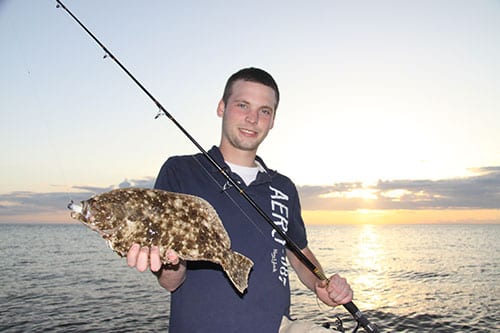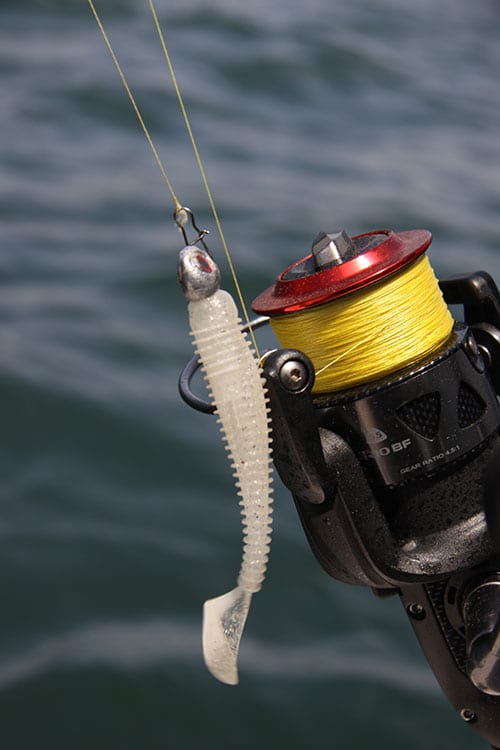
By Tom Schlichter
The tap came exactly as expected. I had tossed a four-inch curly-tailed grub to the edge of a slight rip making up just yards from the beach and felt the pick-up almost instantly as the lure reached the bottom. Rather than set the hook on contact, I lowered my rod tip gently, then lifted softly to see if there was “extra” weight at the end of the line. Indeed, there was, and a quick snap of the wrist drove the jig point deep into the jaw of a 22-inch summer flattie that would be my second keeper of the morning and, soon thereafter, lunch.
That fat summer flattie turned out to be one of over a dozen I drilled on a morning ebbing tide. Each was taken on relatively light tackle while casting from the shore. The beauty of this beachfront fluke fishing is that it actively engages anglers, can be done on a moment’s notice and it provides a reasonable shot at pulling a keeper or two from amongst the proliferation of shorts that paint the bottom in the shallows. It’s also a great technique for introducing youngsters and novice anglers to both the fun and intricacies of the summer flounder game.
NO NEED TO GO DEEP

While many anglers key on locating deep pockets when probing along the shore for stripers, there’s little need for this while working the Long Island Sound shoreline for fluke. Far more important is arriving as high water is just beginning to retreat as this stage of the tide sucks small minnows, sand fleas, grass shrimp and plenty of other fodder that the toothy flatfish enjoy from the shoreline’s edge and ushers them along the gentle slopes beyond the curl of the waves. It is on these slopes that near-shore fluke stack up, facing into the receding and sweeping current as the dinner bell begins to ring.
Since you’ll be using light tackle and lightweight lures, a gently sloping stretch along a sandy beach is perfect to ply this trade. In fact, all you really need to make this technique work, aside from some agreeable toothed flatties, is four- to eight-foot depths with light currents and calm winds. Deep water and strong currents just make it hard to feel bottom – and strikes – properly with the lightweight spinning outfits that will help you excel at this game.
Where to find the right kind of water? It takes a little searching. The key is to find a sandy stretch, which can require some research since the edges of Long Island Sound tend to be rocky. The best stretches tend to be where sand beaches boarder rockier areas such as the down-tide side of a prominent point or down the beach from a harbor mouth.
GEARING UP
Since you’ll be doing a lot of casting, a spinning outfit makes the most sense for this approach. A six-and-a-half foot medium-fast action rod and matching spinning reel capable of handling 12- to 15-pound monofilament lines or 20- to 40-pound test braid works very well in most situations, although I’ll drop down to as little as 8-pound test in some areas where cut-offs seem unlikely. I’ve been using a KastKing Kodiak 5000 (https://www.amazon.com/kastking) for most of my shoreline fluking over the past two years. It’s lightweight enough that I can enjoy the fight of larger shorts and it has no trouble handling keepers and the occasional mini-doormat. I also like this reel because it can subdue false albacore, bluefish and stripers, which are always a possibility when working the Sound. For line, 30-pound test KastKing KastPro braid is a solid choice. You can go lighter than this setup in areas where bass and blues are infrequently encountered. The KastKing Orcas 3000 is a good choice in such instances.

As a rule when targeting Sound fluke from shore I fish a lightweight bucktail rig. My favorite choice is a 4- or 5-inch white, pink or chartreuse curly tailed grub or sand eel imitation on a ½ to 1-ounce red, white or chartreuse round jighead. On purpose, I usually, miss-match the color of the head with the body. Spro bucktails are another good choice. I’ll tip these with a single spearing, 4- to five-inch strip of squid or thin strip of sea robin. I like adding the scent and feel of real meat to my offerings, but you can catch on these rigs with no additions, especially if you substitute a 4-inch Berkeley Gulp! Swimming Mullet for the grub or sand eel imitation. Either way, the terminal end consists of a 90-lb test barrel swivel connected to a 4-foot length of 20-lb. test mono or fluorocarbon leader tied directly to the jig using a Rapala Loop Knot.
While Spro bucktails and small jig heads have long been my go to options for shallow water fluke, I am planning to cut a new offering into my arsenal this year. It’s a new lure called the Fluke Train that I helped develop for Panther Martin. Essentially, we took the jighead and split the weight into three smaller pieces and rigged them up like a Carolina largemouth bass rig so they click and clack and throw off a lot of color while worked across the bottom. In field tests last summer, this rig really kicked butt. You can check them out at www.panthermartin.com.
A PARALLEL UNIVERSE
It might seem logical to cast as far off the shore as possible when standing on the beach but that’s not always the best idea when targeting fluke from shore. The currents of Long Island Sound have a pronounced west to east sweep in many areas as the tide begins to retreat. This sweep draws small baitfish and other tasty fluke delights over the lip that borders the shore, then down along the beach. To take advantage of this natural chum slick, and to add a little extra wiggle to your lure’s action by drawing it against the current, cast down-tide and at a 30- to 60-degree angle from the shore. This should keep your lure in the strike zone tight to the bottom and moving enticingly for the greatest amount of time on each cast.
Retrieves with this shorebound jigging technique should be pain-stakeningly slow and methodic. Cast out, allow your lure to settle to the bottom on a loose line, then hop it back in short, four- to six-inch increments. Hop the jig three to five times, let it set for three or four seconds, then repeat. This retrieve covers the bottom thoroughly while providing any tentative fluke following the lure an opportunity to pounce. If you hook a fat summer flattie, or even miss a strike, cast back to the same spot several times before directing future casts a few degrees in either direction as fluke often line up parallel to the beach and several can be taken with nearly identical casts. One day two summers ago, I drilled over a dozen fish, including a five-pounder, by repeating a single cast again and again for more than 40 minutes.









